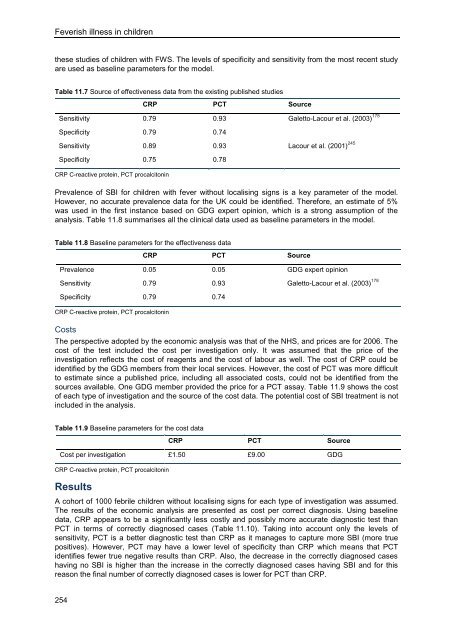A5V4d
A5V4d
A5V4d
You also want an ePaper? Increase the reach of your titles
YUMPU automatically turns print PDFs into web optimized ePapers that Google loves.
Feverish illness in children<br />
these studies of children with FWS. The levels of specificity and sensitivity from the most recent study<br />
are used as baseline parameters for the model.<br />
Table 11.7 Source of effectiveness data from the existing published studies<br />
254<br />
CRP PCT Source<br />
Sensitivity 0.79 0.93 Galetto-Lacour et al. (2003) 178<br />
Specificity 0.79 0.74<br />
Sensitivity 0.89 0.93 Lacour et al. (2001) 245<br />
Specificity 0.75 0.78<br />
CRP C-reactive protein, PCT procalcitonin<br />
Prevalence of SBI for children with fever without localising signs is a key parameter of the model.<br />
However, no accurate prevalence data for the UK could be identified. Therefore, an estimate of 5%<br />
was used in the first instance based on GDG expert opinion, which is a strong assumption of the<br />
analysis. Table 11.8 summarises all the clinical data used as baseline parameters in the model.<br />
Table 11.8 Baseline parameters for the effectiveness data<br />
CRP PCT Source<br />
Prevalence 0.05 0.05 GDG expert opinion<br />
Sensitivity 0.79 0.93 Galetto-Lacour et al. (2003) 178<br />
Specificity 0.79 0.74<br />
CRP C-reactive protein, PCT procalcitonin<br />
Costs<br />
The perspective adopted by the economic analysis was that of the NHS, and prices are for 2006. The<br />
cost of the test included the cost per investigation only. It was assumed that the price of the<br />
investigation reflects the cost of reagents and the cost of labour as well. The cost of CRP could be<br />
identified by the GDG members from their local services. However, the cost of PCT was more difficult<br />
to estimate since a published price, including all associated costs, could not be identified from the<br />
sources available. One GDG member provided the price for a PCT assay. Table 11.9 shows the cost<br />
of each type of investigation and the source of the cost data. The potential cost of SBI treatment is not<br />
included in the analysis.<br />
Table 11.9 Baseline parameters for the cost data<br />
CRP PCT Source<br />
Cost per investigation £1.50 £9.00 GDG<br />
CRP C-reactive protein, PCT procalcitonin<br />
Results<br />
A cohort of 1000 febrile children without localising signs for each type of investigation was assumed.<br />
The results of the economic analysis are presented as cost per correct diagnosis. Using baseline<br />
data, CRP appears to be a significantly less costly and possibly more accurate diagnostic test than<br />
PCT in terms of correctly diagnosed cases (Table 11.10). Taking into account only the levels of<br />
sensitivity, PCT is a better diagnostic test than CRP as it manages to capture more SBI (more true<br />
positives). However, PCT may have a lower level of specificity than CRP which means that PCT<br />
identifies fewer true negative results than CRP. Also, the decrease in the correctly diagnosed cases<br />
having no SBI is higher than the increase in the correctly diagnosed cases having SBI and for this<br />
reason the final number of correctly diagnosed cases is lower for PCT than CRP.


